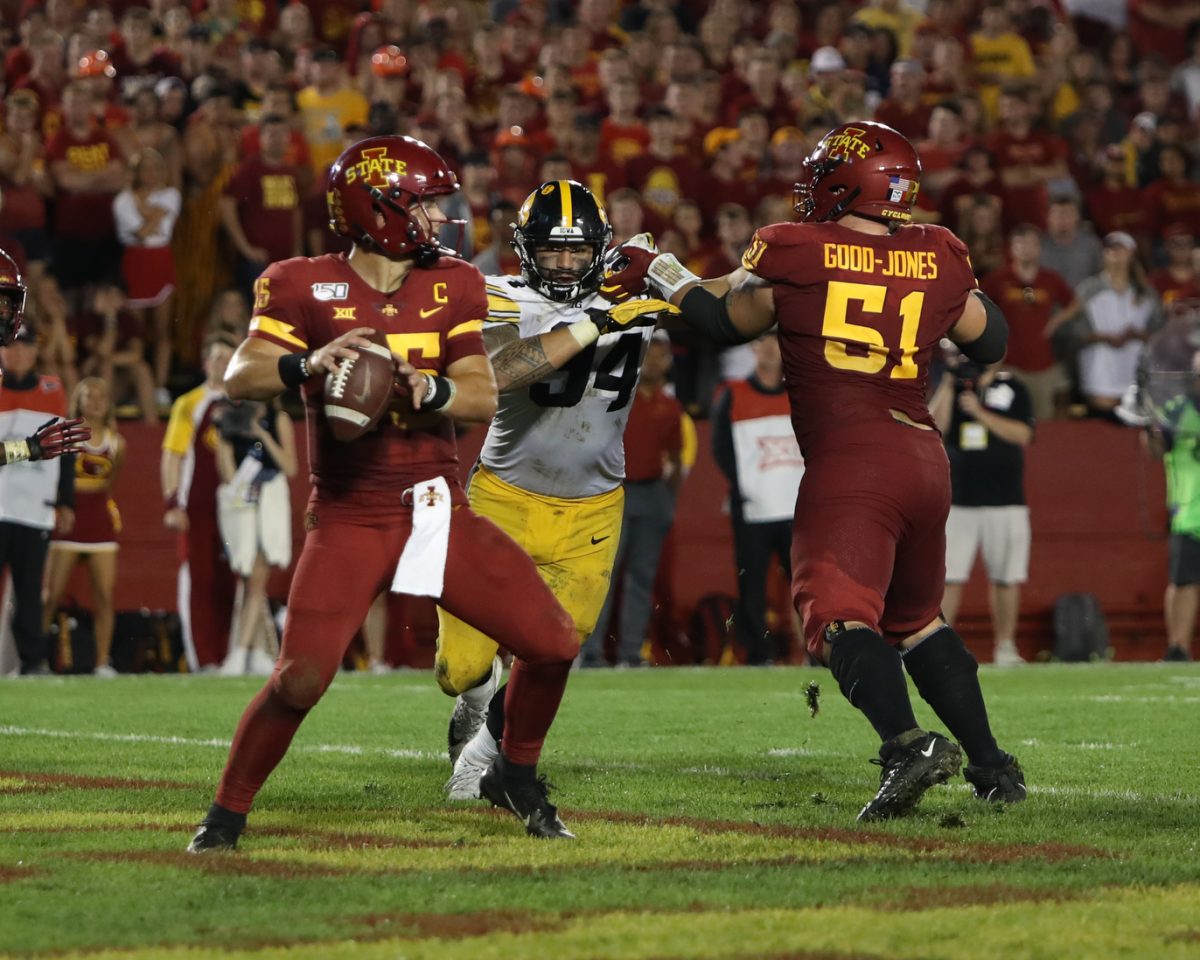Iowa State is a familiar 1-1 heading in to a final non-conference game before marching through the daunting Big 12 schedule. It is not an ideal position, but it is also far from fatal. The pressure of urgency is nigh upon them.
There is much that can be taken from the strange contest against Iowa. Given the circumstances, both teams played within themselves and the delays seemed to have little effect on the outcome. Therefore, there is no blame or praise to be had from the respective responses to the adverse weather situation.
Many have and will focus on the closing sequences of the game with regard to the plays and calls made or not made that determined the outcome. I will not. The closing sequence speaks for itself. Moreover, I contend that the closing sequence was a self-inflicted adversity from prior failures to execute.
It is from that perspective that I provide the analysis below.
Quick Hits
*** I am not sure yet, but in a limited role, I really like what Kene Nwangu brings to the table from the backfield. His explosiveness is a given, but he demonstrated some toughness on Saturday that portends of good things to come.
*** If you doubted the importance of Greg Eisworth to this defense, which no one really does, then all doubts should be laid aside after Saturday. He was the most important player on the field and demonstrated his high level of ability and worth to the Iowa State scheme.
*** I will only mention special teams here. I want to see more before focusing an article on the special teams. With only television angles available, it is difficult to describe what I see. I question the decisions being made schematically, but understand them. Kickers and punters are what they are and you have what you have. But, Iowa State leaves opportunities for yards on the field across the board in their choices and execution, or lack thereof.
*** The offensive line, outside of some difficult snaps, established itself as an average to above average unit against Iowa. Iowa State helped them with its penchant for releasing the ball early and for defined runs versus delayed reads in both phases. However, the unit more than held its own which should be the most encouraging point for the prospects moving forward.
*** The defense was very good, except on third down. A typical trait for Iowa State in the early season. A couple of misreads and sloppy tackling cost them an opportunity to turn in an eye opening performance. Interceptions on balls intended to be intercepted must be made. The opponent was too good to let them get away with an incompletion. The same will be true from here on out.
*** Iowa State has performed below expectation in fundamentals and detail oriented play in the early season for the fourth season in a row. While, the floor is at a higher depth than years past, I struggle to understand the dynamic within the program that leads to early struggles, but results in outstanding growth throughout the schedule. I am not sure it is purposeful, with the exception of the UNI game, but there is a clear pattern that I have noted each year. The good news is that Iowa State has not failed to adjust, adapt, and strengthen its play in October and November. Perhaps 2020 will bring a change in September.
There are a lot of clips gathered below. I do not wish to narrate the game but instead, just demonstrate some things that impacted the game and led me to conclude that the final sequence (penalty and turnover) was less important than some events earlier. In addition, just a note or two about some interesting things pulled out of the re-watch.
The Hole
I am not sure I have written an article in the last two years that has not referenced opportunities for Iowa State to exploit the “hole” that lies in the middle of the field, over the linebackers, and both in front of and between the safeties. It is a pronounced weakness in Iowa’s predominant Cover 2 scheme that is rarely altered.
In my review of the 2017 game, I noted multiple large plays to the hole where Marchie Murdock pressed outside off the line and darted back to the seam at 15 yard depth. Iowa State aggressively attacked the position on their way to a 40 point outing against Iowa. In the 2018 review, I noted two plays, the only ones of note in that contest, where Tarique Milton attacked the same area, in the same way, though from an outside position. Yardage was gained where none was available anywhere else.
Saturday, Iowa State went back to the well again.
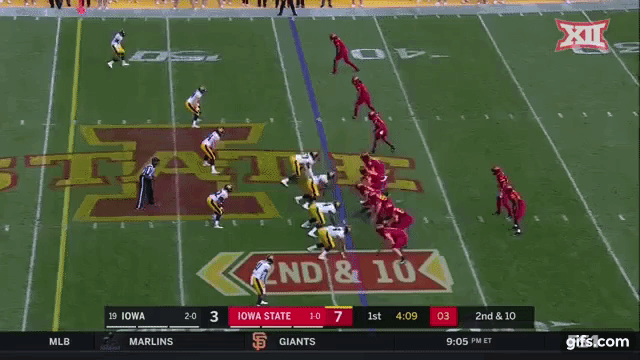
Iowa State attacks the hole directly on the seam. The tight end drag clears the linebacker and the wheel route on the outside pulls the secondary apart. DeShaunte Jones settles in and Purdy is on time with the throw to beat the linebacker, who is incapable of getting over to cover the spot route in the hole. An important 18 yards are earned.
In addition, Charlie Kolar caught multiple passes in the same area and by a similar method. Iowa State attacked this coverage opening adequately, and this play will be shown later in what I believe is the penultimate play of the game.

It was no surprise that Iowa State extended its lead with an explosive play using this familiar concept. Iowa State sends the slot receiver vertical to draw the near side safety off of the seam while folding the outside receiver (Milton) under the vertical route and in between the safeties. However, Iowa walks up the other safety to become a border box player, which allows Milton to exploit the Iowa “go forward” tendency. Excellent play design.
Losing Contain
As we will see, the defense was not without its flaws in the Iowa game. A costly breakdown occurred on multiple occasions to Iowa State’s great detriment. That is the complete loss on contain.
Contain references an edge player (end, linebacker, or safety) that is responsible for turning a play back to the inside where there is help, or spilling the play outside horizontally to a contain player and for the pursuit to chase down. Contain is important because there is no one else behind the contain player to prevent large gains in the event contain is not held. See below.
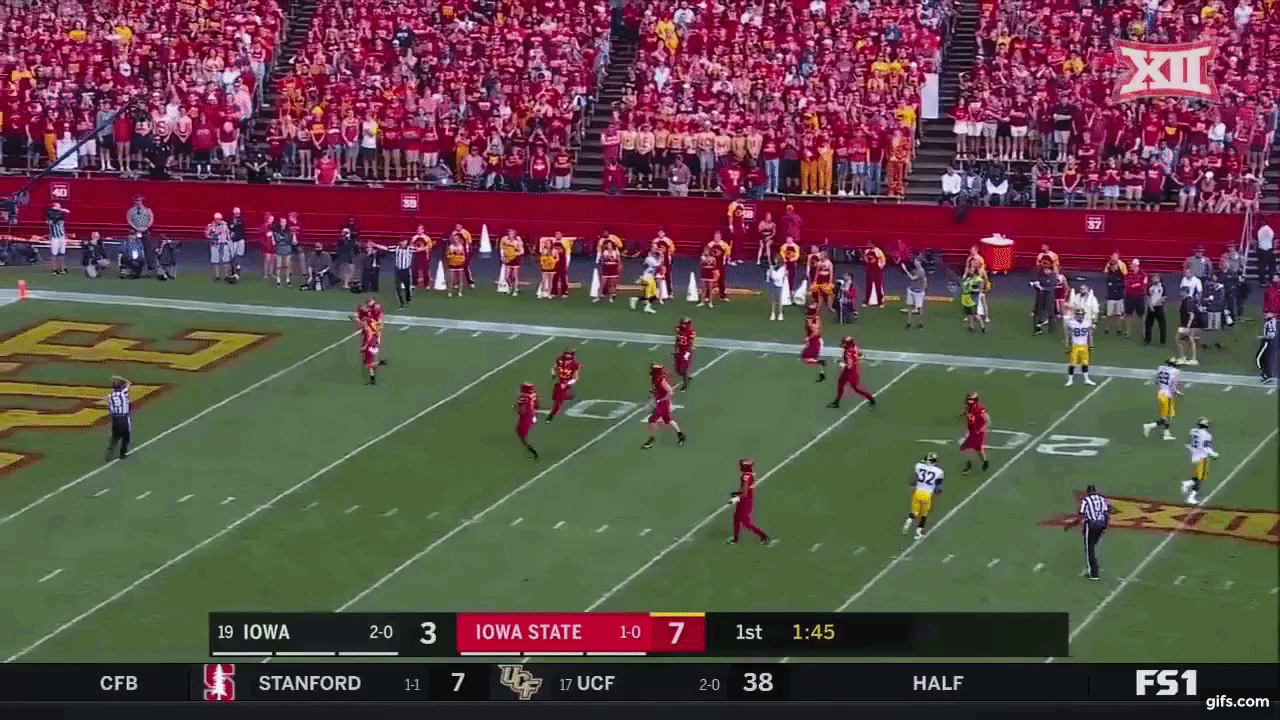
Iowa runs outside zone here and Iowa State slants to the direction of the play. The running back sees a cloudy mess and cuts back where the backside contain has been washed down. A significant gain becomes available.
Watch Mike Rose (23). Instead of reading cloudy to clear and protecting the backside edge, he moves forward in the wash. With Jake Hummel filling and Rose’s initial step replacing Hummel, Rose was likely tasked with containing off the back side edge. Instead, he is washed down and there is no contain player.
Matt Leo is fighting across the face of the lineman pursuant to his slant assignment. He makes a nice recovery and gets in on the tackle, but the defense is designed for him to fight across as he is doing. There is a player in every gap and the middle backer, Rose, is supposed to remain free and follow the running back to the hole. In this case, slide to the back edge and clean up the cut back.
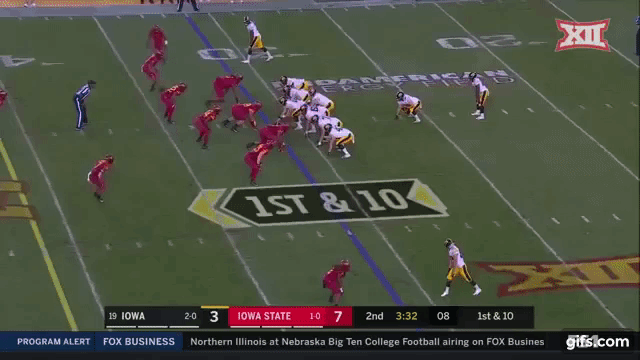
This concept presents in a more consequential context than above. Iowa is driving to pull the margin to 1 point at the half. This play allowed them to do so. If stopped, as it could have been, then Iowa begins to press and the clock becomes an issue. Instead, the large gain places them well within scoring range and stops the clock.
There are several issues and notes on this play.
First, Iowa runs a play – some call it dart – some would use a number system, but regardless, it is a stretch type play where the line is tasked with separating by double team the odd front players. It is an effective run against Iowa State because they often play the ends in a 4 technique inside which gives an angle for the double team and creates space if the outside block is held.
Iowa State reads outside zone here, which is wrong. You can tell by watching Marcel Spears at the top of the screen. He presses forward to fill in concert with the lineman who fight to fill their gaps by penetrating. No. 71 essentially blocks three flow players due to the misread.
However, Iowa State is not undone. They still have two for two on the outside. Rose is to get off of the block and fill inside in order to spill the play outside to the free contain player, which is the safety moving up. It is also acceptable for Rose to move upfield in contain and have the safety fill the hole hard. Instead, Rose does not define his responsibility and the safety fails to fill or contain.
Ideally, Rose holds the outside edge with the safety filling to contain and Spears and/or Vance comes over to fill the C gap. Spears gets out of position, Rose can’t get off the block, and the safety fails to commit. Big play that sets up consequential points for Iowa.
Left on the Field
-3, at least
The following sequence of plays resulted in points being left on the field due to a lack of execution by Iowa State. Not mistakes. There were plenty of those, but they were largely isolated to special teams. Instead, Iowa State failed to execute in a crucial series of plays that set up Iowa to remain close and ultimately take a lead in the ball game.
The Milton touchdown has just occurred. First down for Iowa. The Iowa quarterback throws an ill-advised pass and Mike Rose is there to intercept it. Except he doesn’t. The ball lays on his chest, but he fails to capitalize. The potential turnover was inside of the opponents 40 yard line. Iowa State would have at least had an opportunity to attempt a field goal.
Now, Greg Eisworth fills the hole on 3rd and 1 like a locomotive, thus mitigating, only slightly, the missed turnover opportunity.
Iowa punts, three and out, which gives Iowa State the chance to mount another impressive drive and extend the lead in accordance with their level of play to this point in the game. In no man’s land, the 37 yard line going in, this happens…
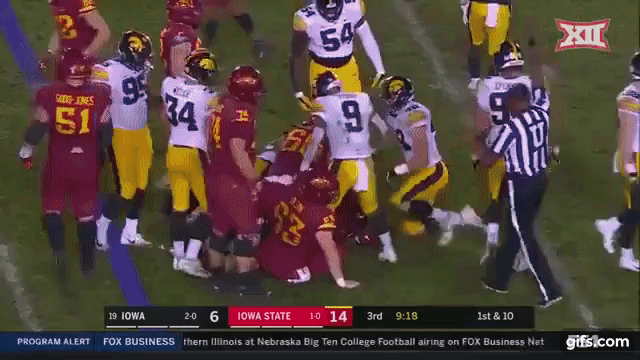
Watch Landen Akers from the slot to the bottom of the formation.
Purdy looks to the stop by Allen and checks down quickly. The Akers route is not a clear route based on Akers turning to look for the ball as soon as Allen sticks. They were crossing the stick route and it worked perfectly. Purdy had time, but missed an opportunity to extend the drive in to scoring range. Instead, ISU punted from the 37.
Near interception-momentum stop-right play call-missed read, gives Iowa the chance to narrow the margin versus Iowa State extending the margin to an unreachable height.
-6
Iowa has 26 yards to cover in order to score a go ahead touchdown. Iowa State can remain ahead if they can continue to have success against Iowa in the red zone.
However, Iowa has the secret weapon known as the quarterback scramble. The statuesque quarterback runs for 20 of the 26 yards, and Iowa State trails when the game should have been out of reach.
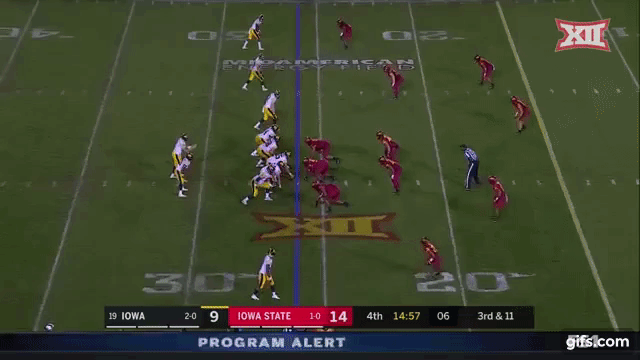
Watch No. 5 for Iowa State and tell me if that looks right to you?
The two inside backers are blitzing the A gaps. Enyi comes off as he is supposed to in order to check for screens and contain the edge. The back crosses his face but in a full release. He is to drop square and widen to the flat to disrupt any screen and prevent exactly what happens. Instead, he turns his back to the edge and allows Iowa to convert 3rd and 11.
If this is executed correctly, then Iowa kicks another field goal and Iowa State remains in the lead. The pressure dynamic changes and so does the game.

Iowa State runs a double loop up front and both Jamahl Johnson and Enyi Uwazurike get home. Except they don’t. But wait, O’Rien Vance is a a spy and is in position to fill the hole and stop the play for a loss. Except, he doesn’t.
I cannot explain why Johnson does not explode through the midsection and I cannot explain the Vance slip. Both were in prime position to make a major, game changing, play. They just didn’t.
Iowa scores on the legs of its immobile quarterback, and Iowa State is -6.
-4
After losing the lead, Iowa State orchestrates a truly masterful and gutty drive inside the 10. A touchdown erases a few of the execution lapses and leaves plenty of time on the clock should the defense fail to hold upon change of possession.
If you recall, the very first clip shown above regarding Iowa State slipping in to the hole from its inside slot or wing position, is demonstrated again here with the game on the line.
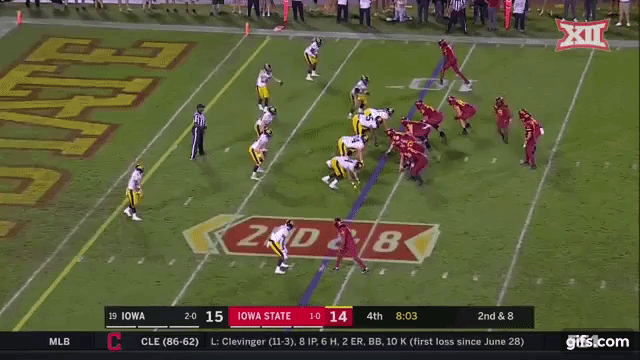
2nd and 8, ISU slips Charlie Kolar right in to the hole. Purdy bails and backfoots the throw causing it to rise too high for even Charlie Kolar. Though there was late pressure, there was time to drive the ball on balance.
Though execution of the play would not guarantee a win, it would become much more likely and build confidence in the event an answer would be needed. This play is simply a lack of execution by the quarterback. The play call is excellent, the route is where it is supposed to be, No. 66 could do a better job of holding up the 3 tech, but this is a play that has to be made to win big time football games. Iowa State is held to 3 points when 7 was needed and available.
-3
Iowa needs two to tie and three to win. They have 75 yards for a touchdown and approximately 50 yards to drive for a comfortable winning field goal. This is a comfortable situation for Iowa and the Iowa State defense must execute at a high level in order to preserve a win.
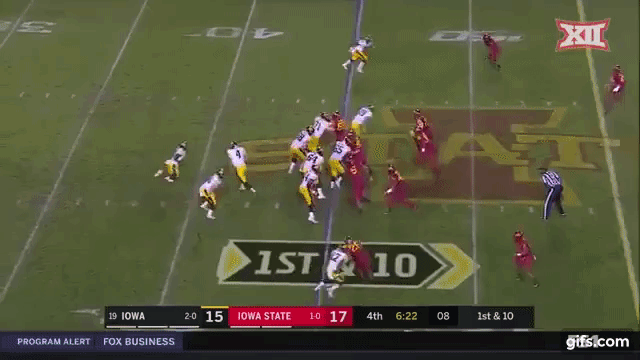
Iowa gains 28 of its needed 50 yards on one play.
Iowa State brings a corner blitz. Lawrence White replaces the blitzer in coverage. There is no threat to the flat, therefore, his job is to deepen under the route released behind him. Instead, he gets caught looking in at the blitz and leaves the throwing lane wide open for the Iowa quarterback. If White drifts back with the route, the pressure likely gets to Stanley and the drive takes on a different complexion.
The catch puts Iowa in field goal range if they do not pick up another yard. It is a dagger throw and catch by Iowa, but it was made possible by poor execution on the part of an experienced defender.
Summation
Execution was the problem for Iowa State versus outright mistakes. Execution can overcome mistakes, but mistakes are amplified when execution suffers.
The above may be too harsh if you believe execution requires perfection. It does not. It requires fundamental play within the structure called for. Within that, there is a margin of error.
Iowa State let execution issues minimize the number of points it was able to produce. Perhaps Kirk Haaland or Dan Becker can chime in, but based on a fumble in scoring range, errant throws in scoring range, and missed first down opportunities in scoring range, I believe Iowa State scored the minimum amount of points available to them in the game.
Identically, Iowa minimized its scoring opportunities and threats with errant throws and an inability to consistently run the ball. But, when plays had to be made, they were able to “out execute” Iowa State.
Iowa State has begun its 2019 campaign in similar fashion to its 2016, 2017, and 2018 campaign. Early season lack of execution has become a hallmark of this team. However, quick transformation and overwhelming efficiency have been the hallmark of October and November.
The 2019 team is ahead of schedule in the ordinary pace of growth throughout a season. It is behind where I thought it would be or should be, but it is likely to be right on schedule to turn the corner with a big chip on its shoulder.
Keep contain, target an immobile quarterback, drop properly, catch an interception, and follow the play design. That represents the margin between a decisive win and a narrow loss. Correctable, absolutely. The Big 12 is full of quality teams and the competition will be more stout than what was faced on Saturday. However, improve the scoring efficiency through fundamental play that has been shown in the recent past by the same players and there are many wins on the board.


